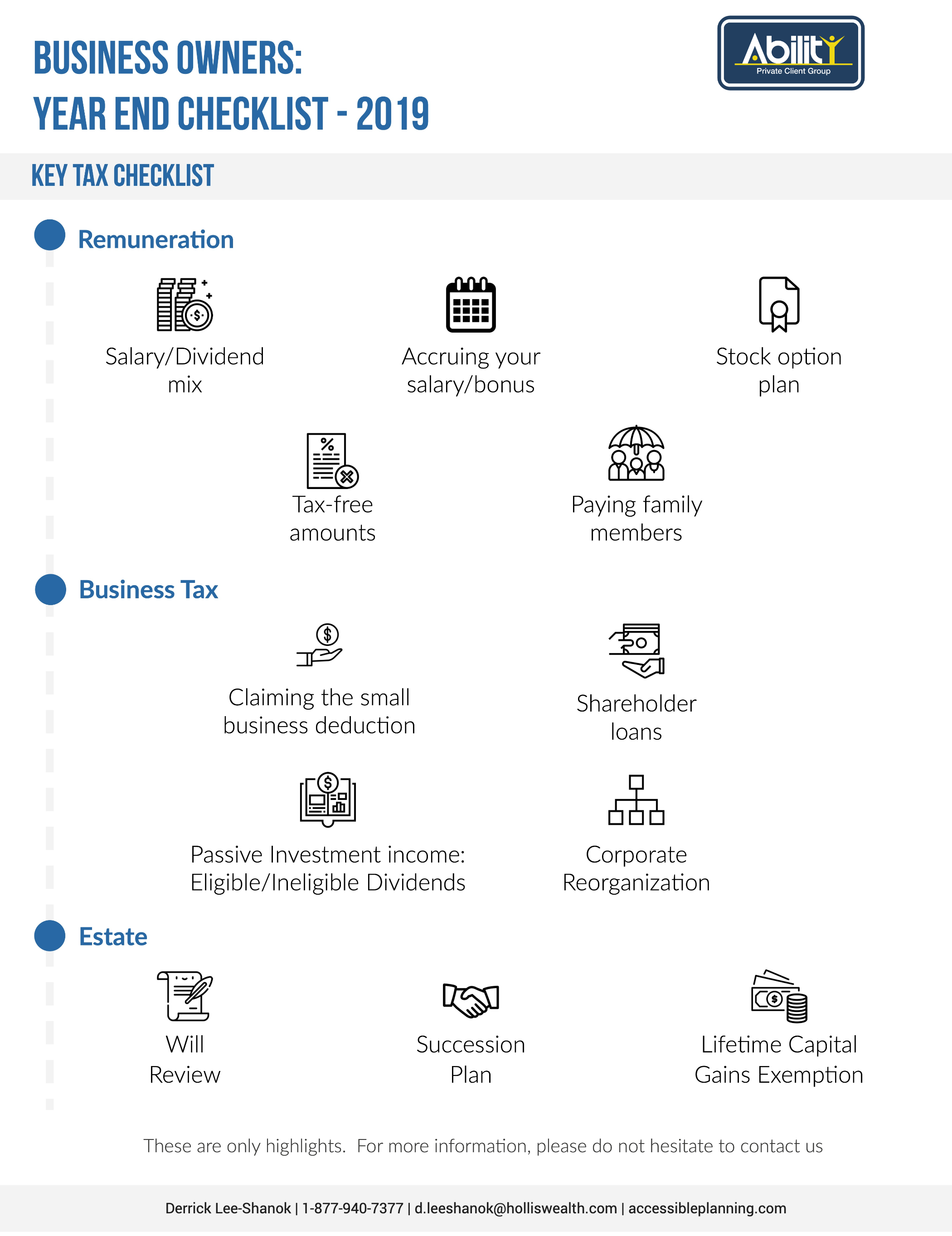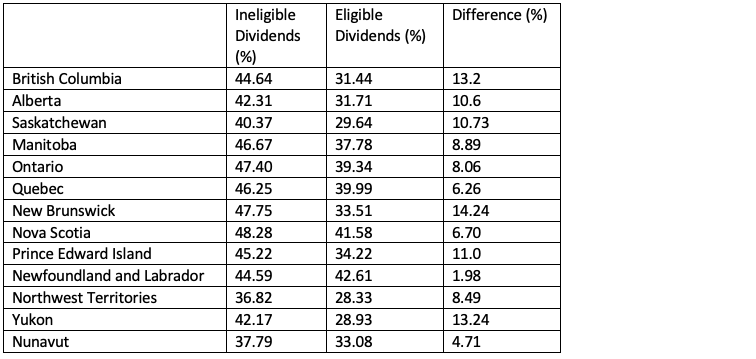
Now that we are nearing year end, it’s a great time to review your business finances. With the federal election over and no major business tax changes for this year, 2019 is a good year to make sure you are effectively tax planning. Please keep in mind that your business may be affected by the recent tax on split income (TOSI) and the passive investment income rules given they came into effect in 2018. These rules can be complicated, please don’t hesitate to consult us and your accountant to determine how this can affect your business finances.
We are also assuming that your corporate year end is December 31, however if it’s not, this is useful when your business year end comes up.
Below, we have listed some of the key areas to consider and provided you with some useful guidelines to make sure that you cover all of the essentials. We have divided our tax planning tips into 4 sections:
Tax checklist
Remuneration
Business tax
Estate
Remuneration
☐ Salary/Dividend mix
☐ Accruing your salary/bonus
☐ Stock option plan
☐ Tax-free amounts
☐ Paying family members
Business Tax
☐ Claiming the small business deduction
☐ Shareholder loans
☐ Passive investment income: eligible/ineligible dividends
☐ Corporate reorganization
Estate
☐ Will review
☐ Succession plan
☐ Lifetime capital gains exemption
What’s your salary/dividend mix?
Individuals who own incorporated businesses can elect to receive their income as either salary or as dividends. Your choice will depend on your own situation consider the following factors:
Your current and future cash flow needs
Your personal income level
The corporation’s income level
TOSI rules
Passive investment income rules
Please also consider the difference between salary and dividends:
Salary
✓ Provides RRSP contribution
✓ Reduces corporate tax bill
• Payroll tax
• Canada Pension Plan (CPP) contribution
• Employment Insurance contribution
Dividend
• Doesn’t provide RRSP contribution
• Doesn’t reduce corporate tax bill
• No tax withholdings
• No Canada Pension Plan contribution
• No Employment Insurance contribution
✓ Receive up to $50,000 of ineligible dividends at a low tax rate depending on province
As part of this, it’s worth considering ensuring that you receive a salary high enough to take full advantage of the maximum RRSP annual contribution that you can make. For 2019, salaries of $151,278 will provide the maximum RRSP room of $27,230 for 2020.
Is it worth accruing your salary or bonus this year?
You could consider accruing your salary and / or bonus in the current year but delaying payment of it until the following year. If your company’s year-end is December 31, your corporation will benefit from a deduction for the year 2019 and the source deductions are not required to be remitted until actual salary or bonus payment in 2020.
Stock Option Plan
If your compensation includes stock options, please check if you will be affected by the new proposed stock option rules. This caps the amount of certain employee stock options eligible for the stock option deduction at $200,000 after December 31, 2019. The rules will not affect you if your stock options are granted by a Canadian controlled private corporation.
Tax Free Amounts
If you own your corporation, pay tax-free amounts if you can. Here are some ways to do so:
Pay yourself rent if the company occupies space in your home.
Pay yourself capital dividends if your company has a balance in its capital dividend account.
Return “paid-up capital” that you have invested in your company
Do you employ members of your family?
Employing and paying salary to family members who undertake work for your incorporated business is worth considering as you could receive a tax deduction against the salary that you pay them, providing that said salary is “reasonable” in relation to the work done. In 2019, the individual can earn up to $12,069 and pay no federal tax. This also provides the individual with RRSP contribution room, CPP and allow for child-care deductions. Bear in mind additional costs that are incurred when employing someone, such as payroll taxes and contributions to CPP.
Claiming the Small Business Deduction
Are you able to claim a small business deduction? The federal small business tax rate decreased from 9% in 2019 (from 10% in 2018) and not anticipated to increase in 2020. From a provincial level, there will be changes in the following provinces:
Small Business Tax Rate

Therefore, a small business deduction in 2019 is worth more than in 2020 for these provinces.
Should you repay any shareholder loans?
Loaning funds from your corporation at a low or zero interest rate means that you are considered to have benefited from a taxable benefit at the CRA’s 2% interest rate, less actual interest that you pay during the year or thirty days after it. You need to include the loan in your income tax return, unless it is repaid within one year after the end of your corporation’s taxation year.
For example, if your company has a December 31st year-end and it loaned you funds on November 1, 2019, you must repay the loan by December 31, 2020, otherwise you will need to include the loan as taxable income in your 2019 personal tax return.
Passive investment income
If your corporation has a December year- end, then 2019 will be the first taxation year that the new passive investment income rules may apply to your company.
New measures were introduced in the 2018 federal budget relating to private businesses which also earn passive investment income in a corporation that also operates an active business.
There are two key parts to this, as follows:
Limiting access to dividend refunds. Essentially, a private company will be required to pay ineligible dividends in order to receive dividend refunds on some taxes which, in the past, could have been refunded when an eligible dividend was paid.
Limiting the small business deduction. This means that, for the companies mentioned above, the small business deduction can be reduced at a rate of $5 for every $1 over between $50,000 and $150,000 of investment income, or eliminated if investment income exceeds $150,000. Please note that Ontario and New Brunswick have indicated that they will not follow the federal rules.
If your corporation earns both active business and passive investment income, you should contact us and your accountant directly to determine if there are any planning opportunities to minimize the impact of the new passive investment income rules.
Think about when to pay dividends and dividend type
When choosing to pay dividends in 2019 or 2020, you should consider the following:
Difference between the yearly tax rate
Impact of tax on split income
Impact of passive investment income rules
With the exception of 2 provinces, Quebec and Ontario, the combined top marginal tax rates will not be changing from 2019 to 2020 on a provincial level. Therefore, it will not make a difference if you choose to pay in 2019 or 2020.
Combined Marginal Tax Rate

In Quebec and Ontario, because there are slight increases in the combined marginal tax rate, there are potential tax savings available if you choose to pay dividends in 2019 rather than in 2020.
When deciding to pay a dividend, you will need to decide to pay out eligible or ineligible dividends, you should consider the following:
Dividend refund claim limits: Eligible refundable dividend tax on hand (ERDTOH) vs Ineligible Refundable dividend tax on hand (NRDTOH)
Personal marginal tax rate of eligible vs. ineligible dividends
Given the passive investment income rules, typically, it makes sense to pay eligible dividends to deplete the ERDTOH balance before paying ineligible dividends. (Please note that ineligible dividends can also trigger a refund from the ERDTOH account.)
Eligible dividends are taxed at a lower personal tax rate than ineligible dividends (based on top combined marginal tax rate). However, keep in mind, when ineligible dividends are paid out, they are subject to the small business deduction, therefore the dividend gross-up is 15% while eligible dividends that are subject to the general corporate tax rate have a dividend gross-up is 38%. It’s important to talk to a professional to determine what makes the most sense when determining the type of dividend to pay out of your corporation.
Combined Personal Top Marginal Tax Rate on Dividends

Corporate Federal Tax Rate and Gross-up factor

Corporate Reorganization
It might be time to revisit your corporate structure given the changes to private corporation rules on income splitting and passive investment income to provide more control on the distribution of dividend income. Another reason to reassess your structure is to segregate investment assets from your operating company for asset protection. (Keep in mind you don’t want to trigger TOSI, so make sure you structure this properly.) If you are considering succession planning, this is the time to evaluate your corporate structure as well.
Ensure your will is up to date
In particular, if your estate plan includes an intention for your family members to inherit your business, ensure that this plan is tax effective following new tax legislation from January 1, 2016. In addition, review your will to make sure that any private company shares that you intend to leave won’t be affected by the new TOSI rules.
Succession plan
Consider a succession plan to ensure your business is transferred to your children, key employees or outside party in a tax efficient manner.
Lifetime Capital Gains Exemption
If you sell your qualified small business corporation shares, you can qualify for the lifetime capital gains exemption (In 2019, the exemption is $866, 912) where the gain is completely exempt from tax. The exemption is a lifetime cumulative exemption; therefore, you don’t have to claim the entire amount at once.
The issues we discussed above can be complex. Contact us and your accountant if you have any questions, we can help.

Mutual funds, approved exempt market products and/or exchange traded funds are offered through Investia Financial Services Inc.

Insurance products are offered through PPI Management Inc., a national licensed insurance marketing organization that support independent advisors with their business, and through multiple insurance companies.